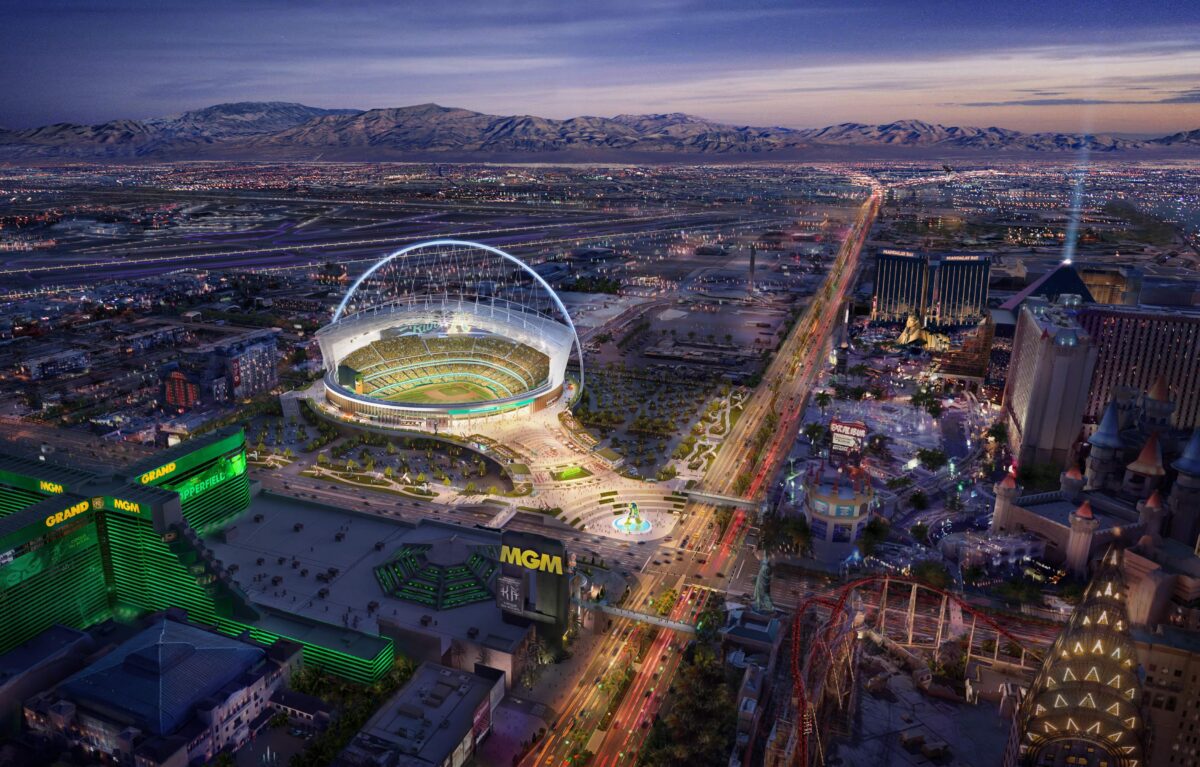Amid questions over stadium size, A’s move to Vegas slowed by relocation vote

Questions raised over the feasibility of fitting a 30,000-seat, retractable-roof Major League Baseball stadium on roughly one-quarter of the Tropicana’s 35-acre south Strip location have not rankled the Oakland A’s nor Bally’s Corp., which operates the Rat Pack-era resort.
A report Friday by the San Francisco Chronicle quoted several baseball stadium designers, economics experts and architects who said 9 acres was too small for the stadium, especially with a retractable roof.
“It could be possible, but it’ll be a challenge,” Brian Powers, a Chicago-based architect and planner at SmithGroup, an architecture and engineering company, told baseball columnist John Shea. “Anything smaller than 14 or 15 acres will require some out-of-the-box thinking.”
The site would have one of the smallest footprints of any Major League Baseball stadium.
“We don't feel there are any issues with the 9 acres,” an A’s spokesperson said Tuesday, adding that Bally’s was providing the team another “3 to 4 acres of shared space” that will be included in the design for the plaza area and stadium entrance.
The questions were raised two weeks after Gov. Joe Lombardo signed off on SB1, a bill approved in a special session of the state Legislature that will provide up to $380 million in public money toward the construction of the $1.5 billion baseball stadium on the Strip.
Rhode Island-based Bally’s, which leases the Tropicana site from real estate investment trust Gaming and Leisure Properties (GLPI), plans to close and demolish the hotel-casino, but not for another two years. Bally’s plans to build a new resort on the acreage not taken up by the ballpark.
“We haven't made those plans yet," Bally’s Chairman Soo Kim told KTNV on June 16. "Now that we've gotten through the political process, now that that uncertainty has passed, now the real work begins. I think there's time.”
In a statement to The Nevada Independent, a Bally’s spokesperson didn’t answer a question about whether the company would provide the A’s with any additional land beyond the 9 acres for the ballpark.
“[Bally’s] will determine how best to utilize the remaining 26 acres,” the spokesperson said. “Bally’s and the Oakland A’s will continue to work together to develop an integrated plan that is mutually beneficial to both companies and allows for the development of a unique experience for customers and fans unlike anything else in the world.”
From mid-April to mid-June, when the A’s announced an initial site for the ballpark to the seven-day special session of the Legislature, the stadium issue was a fast-paced affair.
But public activity has since slowed.
Things may remain quiet until Major League Baseball owners approve a relocation plan that would bring the A’s to Las Vegas. The A’s spokesperson said the timing of when the league will consider the relocation plan was unclear. However, both Major League Baseball and the A’s said the move must be approved by the end of the year.
Clark County spokeswoman Jennifer Cooper said Tuesday that the county can’t issue an estimated $120 million in bonds until other agreements beyond the relocation plan are reached, including the development agreement with the county and the A’s depositing an initial $100 million in private financing for the project.
“That's the first step, right, because otherwise, we would be issuing bonds on something that isn't able to be constructed,” Cooper said.
The team told state lawmakers the stadium won’t be ready until the start of the 2028 season. However, the A’s have not disclosed how the team will finance its $1.1 billion portion of the project — more than 75 percent of the cost.

In the meantime, the A’s along with in-house architects and designers have focused on designing the stadium to fit within the 9 acres that Bally’s has said it would give the team free of charge. The team plans to hire a design architect, a construction firm and a project manager at some point.
According to the Chronicle, six teams have opened retractable-roof ballparks since 1998, most recently in Arlington, Texas, where the Texas Rangers stadium sits on 13 acres with a 5.5-acre roof opening. The roof rests on a track over a parking lot when not covering the field.
One other Major League team, the Kansas City Royals, is exploring relocating to a stadium in downtown Kansas City or north Kansas City on at least 25 to 30 acres where the team can create an entertainment district.
Tropicana or bust
If, for some reason, the site is determined to be too small or is rejected, the legislative process would have to start over. One of two amendments added to SB1 following a contentious Senate hearing on June 7 tied the stadium to the Tropicana site after the original legislation was termed “site agnostic” by proponents — meaning the legislation would follow with the stadium if the location was changed.
According to sources familiar with negotiations, several lawmakers were concerned because the A’s had already changed the site once, announcing a “binding agreement” with Red Rock Resorts on 49 acres west of Interstate 15, only to pivot a few weeks later in favor of the Tropicana location.
The amendment identified the Tropicana stadium site as “the general location of which must be in the county at the southeast corner of Las Vegas Boulevard and Tropicana Avenue.” It did not address the total acreage for the ballpark.
A’s bill proponents said leaving the site open was similar to how lawmakers handled the 2016 legislation for the eventual Las Vegas Raiders stadium. The site for what is now Allegiant Stadium wasn’t chosen until several months after the special legislative session.
Some lawmakers worried the stadium site could move again, possibly to a location they and their constituents would find unfavorable.
“There was some concern that the site would change. Legislators wanted [some] certainty relative to the [Tropicana] location,” said a source familiar with the discussions, granted anonymity to speak freely about the process.
